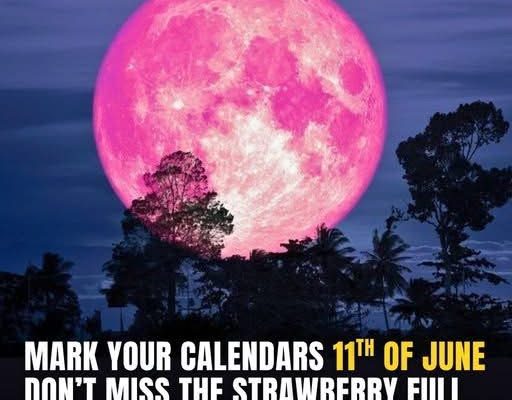Skywatchers, mark your calendars—June 11 brings the enchanting Strawberry Moon, the final full moon of spring and one of the most captivating lunar sights of the year. As it climbs low on the horizon, this moon will glow in rich golden tones, sometimes blushing with a soft rose hue, casting a magical light that’s impossible to ignore.
This will be 2025’s sixth full moon, a celestial gem that often signals the transition into summer. While it doesn’t always align with the summer solstice, when it does—as it did in 2016—it creates a truly unforgettable sight. NASA astronaut Jeff Williams captured its stunning rise from space that year, calling it a “spectacular” view from the International Space Station.
In 2023, the Strawberry Moon lit up the New York skyline, perfectly framing the Statue of Liberty and inspiring a wave of breathtaking early-morning photos.
Whether you’re a seasoned stargazer or just looking for a reason to stay out under the stars a little longer, this is one moonrise you won’t want to miss.

What Is the Strawberry Moon—And Why Is It Called That?
The Strawberry Moon doesn’t get its name from its color—but rather from its timing. According to the Old Farmer’s Almanac, the name comes from the traditional strawberry harvest in June. Just as May’s Flower Moon celebrates the blooming of spring, June’s full moon marks a season of ripeness and growth.
This moon’s name also has deep cultural roots. According to researchers at Western Washington University, several Indigenous North American tribes embraced the name “Strawberry Moon.” Others gave it seasonal titles like:
- Hatching Moon or Birth Moon, celebrating new life,
- Hot Moon or Blooming Moon, recognizing the growing warmth and abundance of nature.
In Europe, where strawberries are less central to the harvest, June’s full moon has also been called the Rose Moon or the Honey Moon, both evoking the golden hue it often carries—and the sweet first honey harvests of summer.
When and Where to See the 2025 Strawberry Moon
Set your sights skyward on June 10—that’s when the moon will begin to rise, casting a warm amber glow low in the sky. The full moon officially reaches its peak on June 11 at 3:44 A.M. ET.
🌅 Best viewing time: Just after sunset on June 10
📍 Where to look: Low on the southeastern horizon
Here are some approximate moonrise times for popular cities in the U.S.:
- Los Angeles: ~8:00 p.m. local time
- New York City: ~8:30 p.m. local time
This year’s Strawberry Moon also coincides with an exciting cosmic event: the red supergiant star Antares, the brightest star in the Scorpiusconstellation, will be occulted (blocked) by the moon. This rare phenomenon will be visible from Australia, New Zealand, and parts of the South Pacific—particularly during twilight in the west and around 7:00 p.m. local time further east.
How to Get the Best View of the Strawberry Moon
Because the Strawberry Moon hangs unusually low in the sky—especially from the Northern Hemisphere—your best bet is to find a clear, elevated spot with minimal light pollution and an unobstructed view of the eastern horizon.
This year’s moon is also part of a major lunar standstill, a rare astronomical pattern that happens only once every 18.6 years. According to EarthSky, that makes this the lowest-hanging full moon since 2006—a perfect chance to capture it rising dramatically close to the horizon.
💡 Viewing Tips:
- Allow your eyes time to adjust to the darkness—at least 15–20 minutes.
- For a more detailed look at lunar features like mountain ridges and impact craters, use a pair of binoculars or a small telescope.
Whether you’re watching it from a mountaintop, your backyard, or through a lens, this celestial strawberry treat is sure to be one of the most photogenic full moons of 2025.



